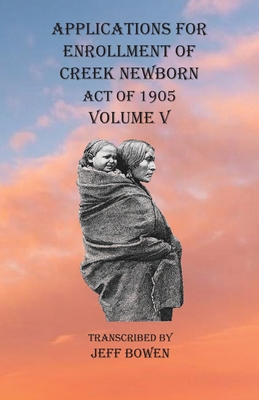Applications For Enrollment of Creek Newborn Act of 1905 Volume V

Applications For Enrollment of Creek Newborn Act of 1905 Volume V
As Mr. Bowen explains in his Introduction, on July 25, 1898, the Interior Department established an Indian Territory Division to administer the Curtis Act of 1898, named for the Native American Senator Charles Curtis of Kansas. The Curtis Act mandated that new tribal population rolls be compiled for inhabitants of the Indian Territory. The leaders of the Creek Nation in Muskogee, who had hoped to retain their tribal organization, resisted this census requirement until 1904-05, when the Dawes Commission announced that its representatives would appear in seven towns of the Creek Nation and accept notarized official applications for its newborn. Once the deadline for these applications had passed, the rolls establishing Creek citizenship would be closed. The Commission accepted applications for 2,410 children by the deadline of midnight, May 2, 1905; however, only 1,171 of those claimants were ultimately approved.
Mr. Bowen's transcriptions include all correspondence associated with the 1,171 successful Creek claimants. Besides the names of all parents and "newborns," the applications include t
PRP: 322.40 Lei
Acesta este Prețul Recomandat de Producător. Prețul de vânzare al produsului este afișat mai jos.
290.16Lei
290.16Lei
322.40 LeiLivrare in 2-4 saptamani
Descrierea produsului
As Mr. Bowen explains in his Introduction, on July 25, 1898, the Interior Department established an Indian Territory Division to administer the Curtis Act of 1898, named for the Native American Senator Charles Curtis of Kansas. The Curtis Act mandated that new tribal population rolls be compiled for inhabitants of the Indian Territory. The leaders of the Creek Nation in Muskogee, who had hoped to retain their tribal organization, resisted this census requirement until 1904-05, when the Dawes Commission announced that its representatives would appear in seven towns of the Creek Nation and accept notarized official applications for its newborn. Once the deadline for these applications had passed, the rolls establishing Creek citizenship would be closed. The Commission accepted applications for 2,410 children by the deadline of midnight, May 2, 1905; however, only 1,171 of those claimants were ultimately approved.
Mr. Bowen's transcriptions include all correspondence associated with the 1,171 successful Creek claimants. Besides the names of all parents and "newborns," the applications include t
Detaliile produsului









